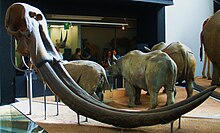Stegodon
| Stegodon | ||||||||||||
|---|---|---|---|---|---|---|---|---|---|---|---|---|

Stegodon zdanskyi skeleton still labeled as Stegodon huanghoensis |
||||||||||||
| Temporal occurrence | ||||||||||||
| Zancleum ( Pliocene ) to Young Pleistocene | ||||||||||||
| 4 million years to 12,000 years | ||||||||||||
| Locations | ||||||||||||
|
||||||||||||
| Systematics | ||||||||||||
|
||||||||||||
| Scientific name | ||||||||||||
| Stegodon | ||||||||||||
| Falconer , 1847 | ||||||||||||
Stegodon is an extinct species of Rüsseltiere (Proboscidea), which belongs to the family of Stegodonten (Stegodontidae). The name is derived from the Greek words stegein (to cover) and odon (tooth) and refers to the pronounced ridges on theanimal'sback teeth (molars). Stegodon livedin Asiafrom the Middle Pliocene to the late Pleistocene and in Africa during the Middle Pliocene.
Development and dissemination
Stegodon evolved from Stegolophodon and appeared for the first time in the Middle Pliocene in Asia. From here the genus spread to Africa, where it was also found south of the Sahara . Here, however , Stegodon disappeared before the Pleistocene. The genus lasted longest in East Asia, where it was part of the so-called Stegodon-Ailuropoda fauna and did not become extinct until the Young Pleistocene. Remains from the Pleistocene can be found from North China to Timor . Stegodon florensis lived on Flores 12,000 years ago and dwarf forms also seem to have survived on Java until the end of the Pleistocene.
features

Stegodon and the Stegodontidae are considered to be closely related to elephants. Certain similarities to elephants result from convergent developments that lead to similar morphological features as those shown by elephants. This includes the relatively short skull and the folded molars, which are reminiscent of today's elephants and had 6–13 cross yokes. However, the molars of Stegodon consisted of a series of low, tile-like ridges, while in elephants each ridge develops a high-crowned plate. The teeth of the stegodonts differed significantly from those of earlier proboscis and probably enabled the stegodon to consume a large proportion of grass food.
In body stature, Stegodon differed significantly from elephants and had the relatively long, low body typical of most early trunk animals. The shoulder height of an animal of the species S. ganesha , which is proven in the Indian Siwalik deposits , was around 3.05 meters. The largest members of the genus, however, were almost 4 meters high and were among the largest proboscis at all. The gigantic tusks of the bulls were up to three meters long and were so close together that the trunk could not dangle between them and was probably carried lying above. On Java, Sulawesi , Timor and Flores, dwarf stegodons developed, which with only 1.2 meters shoulder height were no larger than the dwarf elephants of the genus Elephas (= Palaeoloxodon ).
Way of life
Stegodon was most likely a herd animal and probably lived similar to today's elephants. Stegodon was an animal of the tropics and subtropics and probably inhabited mainly dense forests and tree-rich savannah areas. Finds from northern China suggest that it also advanced to moderate latitudes. The last members of the genus apparently lived in the same habitats as the Asian elephant ( Elephas ) in the late Pleistocene . Since Stegodon , like elephants, lived not only on leaves but also on grasses, it is not clear how both species could coexist without getting into too strong competition. Perhaps Stegodon was a little more adapted to foliage food than elephants.
species

The following species are assigned to the Stegodon :
- Stegodon aurorae : Fossils were found in Japan .
- Stegodon elephantoides ( Myanmar , Java )
- Stegodon florensis ( Flores , Indonesia)
- Stegodon ganesha ( India )
- Stegodon kaisensis
- Stegodon luzonensis ( Philippines )
- Stegodon mindanensis ( Philippines )
- Stegodon orientalis (China, Japan) - Oriental stegodon
- Stegodon shinshuensis (Japan) - Japanese stegodon
- Stegodon sompoensis ( Sulawesi , Indonesia)
- Stegodon sondaari (Flores, Indonesia)
- Stegodon timorensis ( West Timor , Indonesia)
- Stegodon trigonocephalus (Java and West Timor, Indonesia)
- Stegodon zdanski synonym Stegodon huanghoensis ( China )
Individual evidence
- ↑ Julien Louys, Gilbert J. Price, Sue O'Connor : Direct dating of Pleistocene stegodon from Timor Island, East Nusa Tenggara , accessed March 11, 2016.
- ↑ S Yoshikawa, Kawamura, Y .; Taruno, H .: Land bridge formation and proboscidean immigration into the Japanese Islands during the quaternary . In: Journal of Geosciences, Osaka City University . 50, pp. 1-6.
Web links
- The Paleobiology Database: Stegodon
literature
- Paul S. Martin , Richard G. Klein (Eds.): Quaternary Extinctions. A Prehistoric Revolution. The University of Arizona Press, Tucson AZ 1984, ISBN 0-8165-1100-4 .
- Arno Hermann Müller : Textbook of paleozoology. Volume 3: Vertebrates. Part 3: Mammalia. 2nd, revised and expanded edition. Fischer, Jena 1989, ISBN 3-334-00223-3 .
- H. Saegusa: Comparisons of stegodon and elephantid abundances in the Late Pleistocene of southern China. In: G. Cavarretta (Ed.): La terra degli elefanti. = The world of elephants. Atti del 1st congresso internazionale, Roma, 16-20 October 2001. Consiglio nazionale delle ricerche, Rome 2001, ISBN 88-8080-025-6 , pp. 345-349 ( online PDF; 324 kB ).
